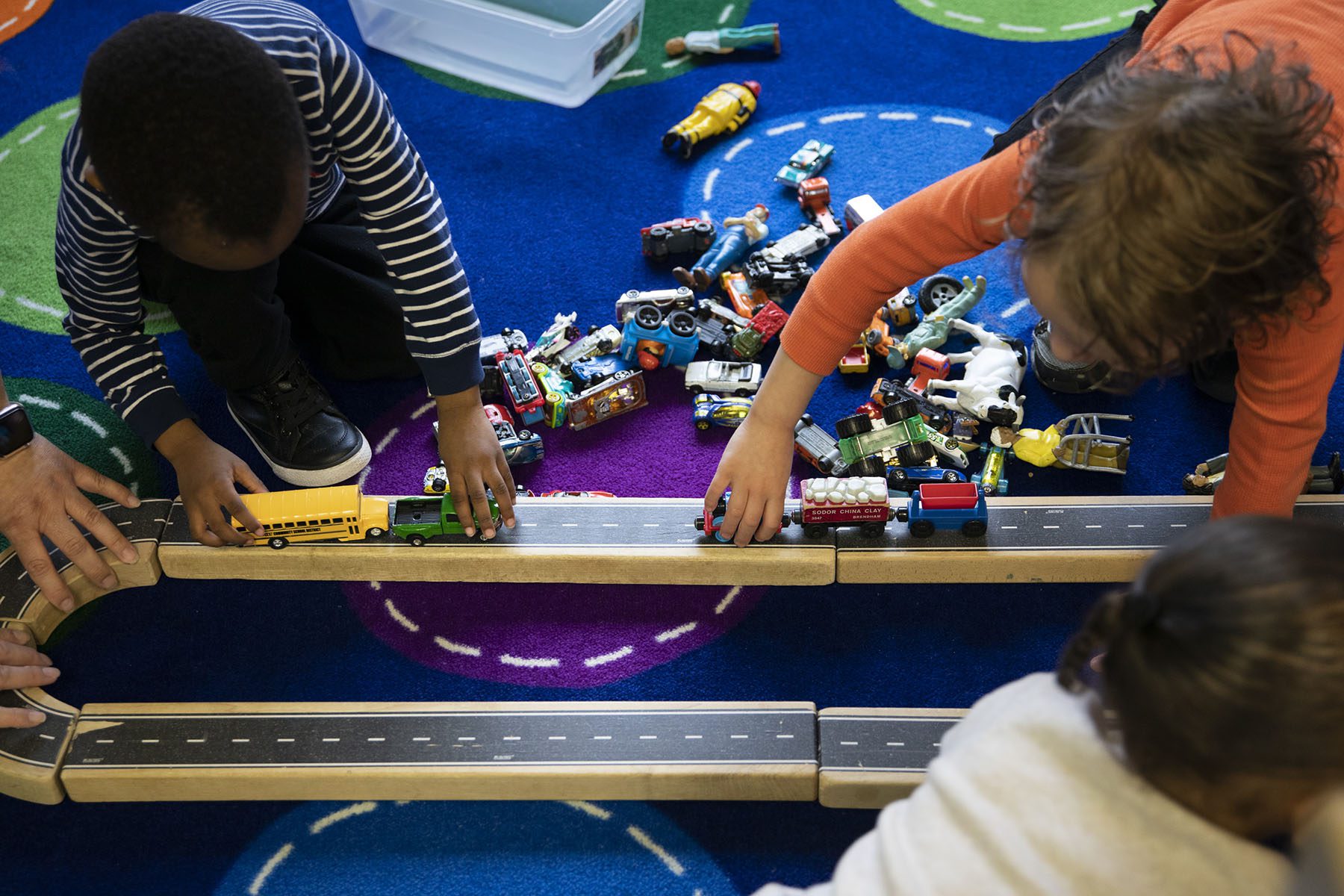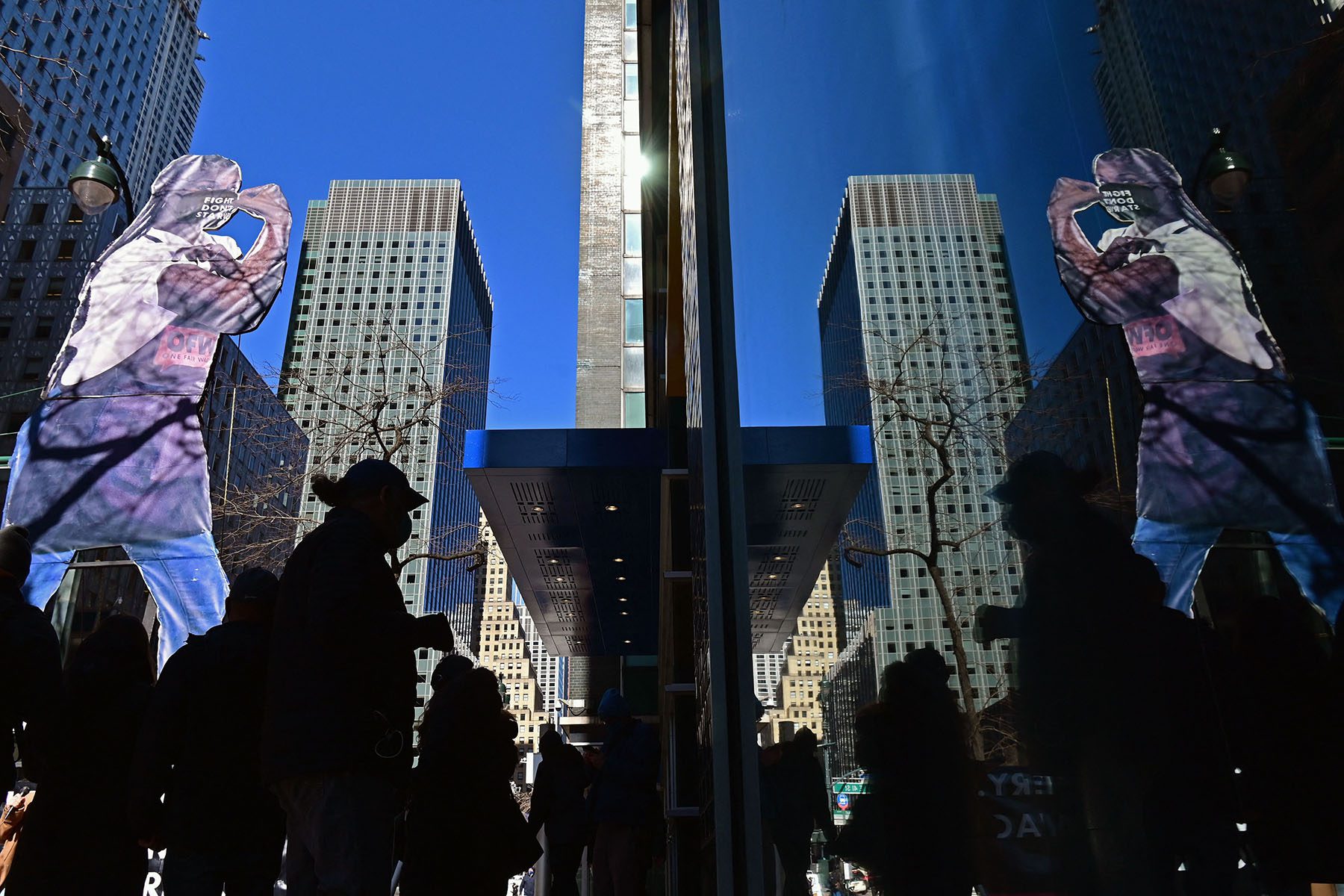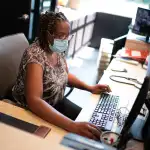We’re answering the “how” and “why” of business & economy news. Subscribe to our daily newsletter.
Last year, Heather McCulloch set out across the country asking women a question that has long been absent from discussions in her field: What would the economy look like if it worked for you?
The findings, first shared exclusively with The 19th, highlight a list of the top challenges women of all backgrounds say are standing in the way of their economic mobility and what they view as the key policy solutions to those barriers.
McCulloch and her research partner, Céline Apollon, sought input from Black women, Latinas, Asian-American and Pacific Islander women, Native American women, transgender women, LGBTQ+ women, women with disabilities and women across the socioeconomic spectrum, from entrepreneurs to service workers. They spoke to people who are often invisible in the policy-making process and literally invisible in much of the data on the economy.
McCulloch, an entrepreneur-in-residence at the Aspen Institute Financial Security Program and the founder of Closing the Women’s Wealth Gap, said the vision was to flip the script on the traditional approach in which White men write economic policies and women are an afterthought.
“What’s happened is that our economy has changed and women, people of color and young folks of color are playing a bigger role … and yet we don’t acknowledge that and in fact I think our political discourse understates the role women are playing,” McCulloch said. “That was one of the drivers for doing the research.”
Concerns around inflation, the impact of high housing costs, the effect of caregiving responsibilities, the struggle of working long hours or multiple jobs in low-wage positions, and the dearth of economic education for women and girls topped the list of challenges all groups of women are facing.
To address those challenges, women wanted to see policy solutions around the nature of work, including more flexible schedules, closing the gender pay gap and promoting more women to leadership positions. They laid out policy solutions for the federal government: support to help cover rising costs, raising income and asset limits for public assistance, raising the minimum wage, enacting a national paid leave policy and increasing access to affordable child care.
What was most fascinating about those results, McCulloch said, was not necessarily the content — all of those are issues that have been affecting women for decades — but how much consensus there was in both what the top challenges and solutions are across racial, ethnic, socioeconomic and gender identity groups. She and Apollon are now presenting their research across the country to advocacy groups and lawmakers, hoping to connect their policy initiatives with the solutions women themselves want to see.
“The big takeaway for me was there's way more commonality than difference for women. And the same was true in terms of political identity. Yet we're being divided for all these other reasons, because of all these other narratives,” she said.
The research team conducted 125 in-depth interviews followed by a survey of more than 1,200 participants that specifically focused on marginalized groups. About 65 percent of respondents were women of color, 37 percent were single mothers, 67 percent had a household income below $50,000 and 32 percent had a disability. McCulloch and Apollon’s research disaggregated the findings by racial and ethnic groups, gender identity and sexual orientation, and other characteristics, including motherhood and the presence of a disability, to understand the needs of each group.
For Black women, discrimination in the workplace remains a barrier they say uniquely depresses their economic advancement, according to the survey. Black women often have the highest labor force participation rate of any group of women, yet stereotypes about their desire to work are still pervasive, said Jocelyn Frye, the president of the National Partnership for Women & Families.
-
More business & economy coverage
- Women and minority business owners relied on Silicon Valley Bank when other banks turned them away. Now what?
- Happy Equal Pay Day? Here are 6 charts showing why it’s not much of a celebration.
- 99% of women-owned businesses say the federal government hasn’t done enough to support them, survey finds
“The reality is that Black women, since the moment they hit the shores of this country, were working, but they were working in a context where they were mistreated and devalued and disrespected. Those women were often treated as commodities, as people who were simply there to serve others,” Frye said. “Those attitudes are still with us.”
Sharita Humphrey, one of the women interviewed for the study, saw how that legacy of discrimination set her own family back. She was raised by a mother who lived paycheck to paycheck in unstable jobs. She didn’t feel she had the financial stability or education to pass on to her children. “All I ever saw were pink slips,” Humphrey said.
Humphrey and her two young sons were evicted from their apartment in Houston and moved into a motel in 2010. Weeks turned to months, and Humphrey decided to forge a different path. For the year they lived at the motel, she read every book the public library had on finances. She got a job as a government auditor and moved her boys into a home.
She eventually parlayed her experience into her own business specializing in teaching personal finance to under-resourced and underbanked people. For her, building an economy that works for her community involves giving people the tools that other communities are born with.
“[Financial literacy] starts at home, but you can't teach what you don't know, so I can’t fault my parents for not teaching me,” Humphrey said. “They say wealth is generational, the lack of financial knowledge is also generational.”
Access to financial education is one solution that rose to the top of McCulloch and Apollon’s research for several groups. Asian-American and Pacific Islander women also ranked the need for better education to gain financial independence highly, and particularly culturally competent education.
The research team spoke to Duenphen Painter, a Thai woman in Washington who has lived in the United States for over a decade working in service and care jobs. But it wasn’t until her husband had a heart attack last year that she had to learn how to use credit cards and access the Medicaid system.
“I don’t know about the American lifestyle,” said Painter, 52. “I need someone to guide me.” She worries she won’t have the tools to help her husband if his health deteriorates again.
Cultural competency is also missing in the workplace for AAPI women, said Sung Yeon Choimorrow, the executive director of the National Asian Pacific American Women's Forum. Workers often don’t know their rights because information about labor laws is not available in their languages. Many AAPI women work in low-paid service jobs where labor violations run rampant.
Similar challenges hold Native American women back from economic advancement, according to the study, but the nuances are different. Native American women face limited job opportunities on reservations, as well as additional bureaucratic hurdles to opening small businesses on Native land, said Diana Bigby, the program manager for Native Women Launch, a program that provides education on business and personal finance to Indigenous women.
Colonization changed how Native American communities approached money and trading — “we didn’t learn about finances,” Bigby said — and how they approached leadership. Matrilineal tribes were forced to put men as leaders in the model of colonizers, and women were placed in predominantly care roles.
That legacy, like the legacies of slavery and immigration, matters because today it has translated to fewer opportunities for women of color. Bigby, who is Nakoda and lives on the Fort Belknap reservation in northern Montana, said Indigenous communities are literally disconnected from the tools they need to be equal participants in the economy.
“We are not really caught up with the rest of the world in some areas,” she said.
Infrastructure issues make accessing child care, something all women highlighted as a key challenge, even more difficult for Native communities. For example, the school Bigby’s 4-year-old attends closed for about a month and a half in the winter because of breaks in faulty water systems. Care options are already extremely limited — most centers on the reservation are at capacity.
The disconnect between care and work is a central tenet of an economy that hasn’t been built for women. The United States is the only industrialized nation that doesn’t have a guaranteed paid family leave policy, and it invests less on children than most other developed countries. Most people can’t secure affordable child care, most providers are barely able to keep centers open, and child care workers — 95 percent of them women — earn some of the lowest wages in the country.
Similarly, there are about 42 million unpaid elder-care workers in the United States. Sixty-one percent of them are women who take on those responsibilities because home care, community-based care and nursing home care options are limited and costly.
That is particularly true for those who live intergenerationally, like many Native, AAPI and Latinx people.
“It’s not just about, ‘Can I afford child care?’” Choimorrow said. “It’s, ‘Can I afford child care and this heart attack that my father just had?’ It really compounds the situation.”

Flor Tenesaca, a home health aide in New York City who helped inform the research, said there are clear signs that systems weren’t designed to recognize the roles many women play as workers and as caregivers. Just think about the time schools let out, she said. She has a 5-year-old son who gets out of school at 3 p.m., but few jobs allow her to be there by that time to pick him up.
Tenesaca, 26, is a single mom and, until recently, was a student working toward a bachelor’s degree in sociology. She has been stuck in low-paying home health aide jobs because they were the only ones with enough flexibility to allow her to pick up her son and study.
This week, she starts a new 9-to-5 job as a care coordinator. Her plan is to have her brother use a bikeshare service to pick up her son at 3 p.m. and take him to her mother’s house, a half-hour commute for Tenesaca after work. She then has to return to Manhattan.
“It’s not easy, single mothers suffer a lot,” she said. A system that works for women would have more employers offer on-site daycare or vouchers to help parents pay for babysitters, she said.
Latinas like Tenesaca are overrepresented in low-paid service and care jobs. That reality was legislated into existence: The New Deal in the 1930s established job protections for U.S. workers, such as the minimum wage and collective bargaining rights, but sectors Latinas and Black women predominantly worked in, such as domestic work and farm work, were left out for decades.
“The overconcentration we see today of Latinas in low-paying jobs is not a result of lack of hard work or tenacity, it’s very much a systemic design,” said Susana Barragán, a policy analyst with UnidosUS, the country’s largest Latinx civil rights and advocacy organization.
For Latinas, top solutions included raising the minimum wage, which has been stagnant since 2009, and raising income and asset limits that restrict access to public assistance programs.
After nearly 30 years in the United States, Liliana Olayo has personally experienced how those systems have neglected her, she told researchers. She immigrated to Chicago from Mexico when she was 17 and often felt cast aside.
Olayo took classes to learn English and get her GED, and her eldest son went to university on a scholarship. But her family struggles with low wages, and the additional challenge of keeping wages low enough to be able to access public assistance.
Earning above the threshold for those programs doesn’t mean her problems magically disappear, said Olayo, 50.
“It's a way to maintain us in that cycle without seeing the hope that I will be able to have money and I will be able to go on vacation with my kids or I can save for my kids,” she said. “You have resign yourself that you need to live in this level of poverty forever.”
The same is true for women with disabilities like Pam Williams, who has lived decades inside a disability assistance system that keeps people in poverty wages, she told McCulloch and Apollon. Williams suffered a traumatic spinal injury at the age of 23. To be able to access the Supplemental Security Income (SSI) program, which provides monthly payments to adults and children with disabilities, she had to spend down $80,000 in savings. The program limits the amount individuals can have in assets to $2,000 — a figure that hasn’t changed in almost 40 years.
Now 61, Williams can only work part-time as a teacher at a community college because managing her disability makes it difficult to work a full-time job, and because her wages can’t exceed $1,913 a month. She regularly goes to a food pantry, grows her own food and shares items with neighbors to get by.
“You’re totally on the system or you’re totally off the system. They keep you below poverty level or just at poverty level,” she said. “It’s like walking on a tightrope: you’re trying to work, you’re trying not to have more than $2,000 in assets.”
Raising the asset limit on SSI is a solution that got some traction last year. Sen. Sherrod Brown, a Democrat from Ohio, pushed forward a bill that would have raised the limit to $10,000 for an individual and tied it to inflation, but it was ultimately left out of the appropriations package that passed Congress in December.
Women make up about half of adults with disabilities on SSI and about two-thirds of retired adults above the age of 65 on the program.
Better targeted government assistance as well as employer assistance for health, transportation, housing and other costs, was something that resonated for LGBTQ+ women the research team spoke to.
For trans women, especially, those solutions are essential, said Christopher Carpenter, the director of Vanderbilt University’s LGBTQ+ Policy Lab.
Gender-affirming health care is expensive and growing more restrictive across the country, and trans people are often left paying down their assets to be able to get Medicaid access. On top of that, a bevy of anti-trans legislation across the country is inhibiting economic growth for trans people.
“The onslaught of social media and print media and the laws and social structures around you saying, ‘We think you shouldnt exist’ — we call this the minority stress hypothesis, how these social stigmas get under the skin.” Carpenter said. “The way that people flourish economically is by being productive at work. It's hard to do that when in fact from all angles people are telling you either explicitly or implicitly, ‘We wish you would leave.’”
Flexible and remote schedules can help alleviate some of that stress brought on by workplace culture, Carpenter said. It’s also the solution that rose to the top for almost every group interviewed.
Joyce Grand, an executive and leadership coach who was also part of the research group, said she has been giving her employees flexibility to work remotely since the 1990s “before we were even talking about it,” which also helped them manage child care and elder care.
That’s a key solution for her: "There has to be a better way for us to accommodate that people have lives outside work,” Grand said.
She worked as the director of operations for 18 years at House of Ruth, a nonprofit that works with women who have experienced abuse or are homeless in Washington, D.C., and saw many families that needed work flexibility to handle child care and elder care needs. She sees it now as she coaches women who are later in their careers and for whom elder care is important.
“It’s like everybody just turns their head to the women in the room and says, ‘Aren’t you going to take care of that?’” said Grand, 69. Much of her work now is also coaching those women to stand up for what they need in the workforce and ensuring they are being compensated fairly.
The gender pay gap is the manifestation of how deeply discrimination is embedded in the economic system for women. As a lesbian, Grand and her wife have faced that two-fold. It took about a decade for them to bring down their collective debt, a phenomenon lesbians experience acutely because they face a double bias and a double pay gap.
The solution Grand sees for women is full transparency around pay. It's something she did in her role as COO. She’d say, “Here is our range for each of the positions, here is how we put you with your given grade within that range and you sure bet that I felt really strongly that I needed to be able to defend it,” Grand said.
Solutions like that will take government investment, but McCulloch also sees the results of her work making the case for private investment, too.
“The policy is critical, but I think sometimes we get so caught up in these battles around policy that we forget that employers have a huge role to play that might be more about them stepping up and demonstrating good practice,” McCulloch said.
Her research speaks to much of what women of color and marginalized women’s lived experiences have been in the United States, said Aisha Nyandoro, the the executive director of Magnolia Mother’s Trust, a program that gives Black mothers $1,000 a month for a year. The issue now is not getting fatigued when it becomes clear those solutions will take time to enact.
“We know the solutions, we know what they are … but what we are missing and what is necessary is the patience to push the solutions forward,” Nyandoro said. “We are a country that wants it quick, fast, now and a lot of these issues are not quick, fast, now issues.”
An economy that works for the women she works with is one that works for all women. Black, low-income mothers are at the intersection of multiple identities that face some of the harshest economic conditions because so many systems around them have neglected them.
When Black women are pulled up, everyone is.
When Nyandoro asks them to define wealth, it’s never about how much money they have in the bank, she said. It’s instead about knowing that if something happens to them, their kids would have something to hold on to. They would have a home. They would have safety.
An economy that works for those women, Nyandoro said, is “an economy that would give them the permission to dream.”







